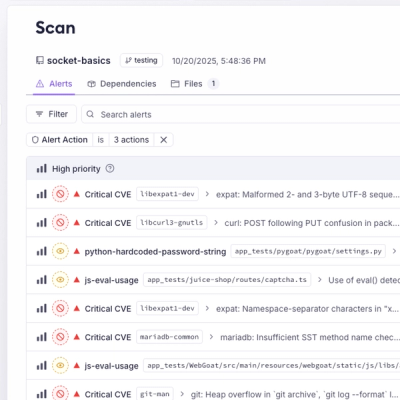
Product
Unify Your Security Stack with Socket Basics
A single platform for static analysis, secrets detection, container scanning, and CVE checks—built on trusted open source tools, ready to run out of the box.
expo-cli-jey
Advanced tools
The fastest way to build and run universal React Native apps for Android, iOS, and the web
📚 Read the Documentation | Contribute to Expo CLI
The @expo/cli package is a CLI binary that should be used via the expo package, like npx expo start (or npx expo for short).
npx expo
⭐️ Be sure to star the Expo GitHub repo if you enjoy using the project!
This CLI has the following purposes:
login, logout, whoami, register. Standard web CLIs don't have authentication commands because they either don't set up https or they use emulation via packages like devcert.Simulator.app, Android Studio, ADB, etc. to make native builds as painless as possible. run:ios, run:android commands.prebuild command that can reliably work with a project for long periods of time. Prebuild is like a bundler for native code, it generates the ios, android folders based on the project Expo config (app.json).
npx expo config is auxiliary to npx expo prebuild and used for debugging/introspection.npx expo install this is a minimal utility born out of pure necessity since versioning in React Native is hard to get right.To develop the CLI run (defaults to watch mode):
yarn build
We highly recommend setting up an alias for the Expo CLI so you can try it in projects all around your computer. Open your .zshrc or other config file and add:
alias nexpo="/path/to/expo/packages/@expo/cli/build/bin/cli"
Then use it with nexpo like nexpo config. You can also set up a debug version:
alias expo-inspect="node --inspect /path/to/expo/packages/@expo/cli/build/bin/cli"
Then you can run it and visit chrome://inspect/#devices in Chrome, and press "Open dedicated DevTools for Node" to get a debugger attached to your process. When debugging the CLI, you'll want to disable workers whenever possible, this will make all code run on the same thread, this is mostly applicable to the start command, i.e. expo-inspect start --max-workers 0.
CHANGELOG.md with changes for every PR. You only need to add the message, our GitHub bot will automatically suggest adding your name and PR number to the diff.async functions with Async like runAsync. This is just how we format functions at Expo.CommandError instead of Error -- this helps with debugging and making the experience feel more coherent.Log module instead of console.log.Something happened (foo: bar, baz: foz).
Something happened: bar, foz or Something happened: foo=bar, baz=foz.expo start), arguments (--port), and --help messages should be modified internally, by the Expo team to ensure the developer experience is unified across Expo tooling. External contributions modifying these core aspects may be rejected.profile utility method with the EXPO_PROFILE=1 environment variable to measure execution time.isOffline boolean.taskr + swc, this is partially inspired by Next.js' local CLI.process.env.__EXPO_VERSION instead of reading the local package.json at runtime.expo meaning the SDK Version is always present.
@expo/cli.@expo/config method getConfig does not need the skipSDKVersionRequirement in any case since expo should always be installed. Ex: getConfig('...', { skipSDKVersionRequirement: true }); shouldn't be used.node_modules folder.
expo package as these may kill the running process. Features that need this pattern (like expo upgrade) should live in standalone global tools.There are two testing scripts:
yarn test: Controlled unit and integration tests.yarn test:e2e: End to end testing for CLI commands. This requires the files to be built with yarn build--watch flag. Example: yarn test --watch config.it blocks. Example it(works).packages/@expo/cli/ folder (i.e. no yarn.lock modifications, etc.) then most native CI tests will be skipped, making CI pass faster in PRs.nock for network requests.describe blocks that wrap all the tests in a file.describe block instead of a stringified function name:
describe(foobar, () => {}) instead of describe('foobar', () => {})fs via memfs whenever possible.npx expo prebuild and npx expo start commands for instance, we utilize a helper method that will default to reusing a project + node_modules when run locally. This can be toggled off to bootstrap a fresh project every time.os.tmpdir() as this folder is automatically cleaned up when the computer restarts.TL;DR:
expo-cliwas 'make it work', whereas@expo/cliis 'make it right, make it fast'.
The legacy global expo-cli package was deprecated in favor of this versioned @expo/cli package for the following reasons:
expo-cli was too big and took way too long to install. This made CI frustrating to set up since you needed to also target global node modules for caching.expo-cli worked for almost all versions of the expo package, meaning it was getting more complex with every release.expo-cli combined service commands (like the legacy build, submit, publish) with project-level commands like expo start. We've since divided services into eas-cli and project commands into npx expo (@expo/cli). This structure is more optimal/faster for developers since they can install/update commands when they need them.$EDITOR instead of the custom $EXPO_EDITOR environment variable. Also transitioning away from $EXPO_DEBUG and more towards $DEBUG=expo:*. These types of changes make Expo CLI play nicer with existing tooling.expo start:web and expo web commands have been rolled into npx expo start as we now lazily load platforms until the device requests them.expo-cli may still be getting migrated over to this new CLI. For a more comprehensive breakdown see the start command PR.FAQs
The Expo CLI
We found that expo-cli-jey demonstrated a healthy version release cadence and project activity because the last version was released less than a year ago. It has 0 open source maintainers collaborating on the project.
Did you know?

Socket for GitHub automatically highlights issues in each pull request and monitors the health of all your open source dependencies. Discover the contents of your packages and block harmful activity before you install or update your dependencies.

Product
A single platform for static analysis, secrets detection, container scanning, and CVE checks—built on trusted open source tools, ready to run out of the box.

Product
Socket is launching experimental protection for the Hugging Face ecosystem, scanning for malware and malicious payload injections inside model files to prevent silent AI supply chain attacks.

Research
/Security News
The Socket Threat Research Team uncovered a coordinated campaign that floods the Chrome Web Store with 131 rebranded clones of a WhatsApp Web automation extension to spam Brazilian users.